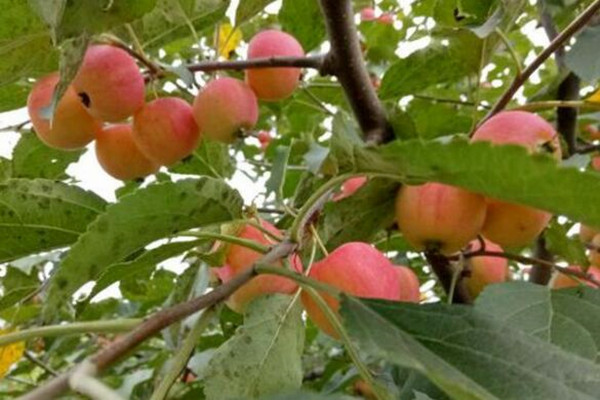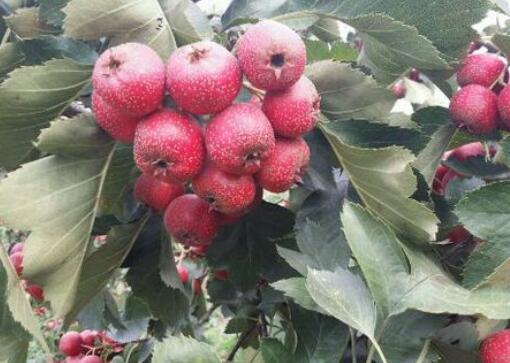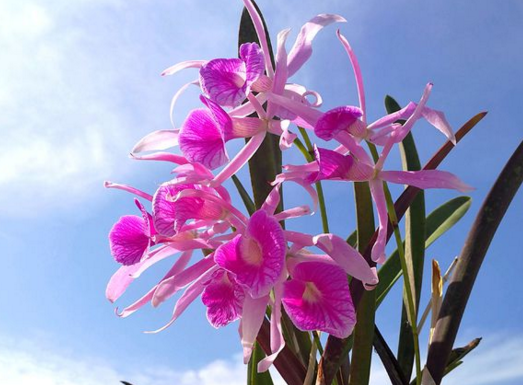How many years does the sand tree blossom and bear fruit? How to plant it? What are the effects and effects?
Sand fruit trees often grow on hillsides, flatlands and valley terraces, eat raw and taste like apples, have many varieties, and can be propagated by grafting, sowing, ramet and other methods. They are endemic to China. Sweet and sour and delicious. So, how many years does the sand tree blossom and bear fruit? How to plant it? What are the effects and effects?

How many years does the sand tree blossom and bear fruit?
Sand trees usually take three years from planting to a large number of fruit, and begin to bear fruit in the fourth year after planting. Therefore, in order to ensure the number of fruit trees, it is necessary to do a good job in field management such as soil improvement, planting density, seedling management and so on in the three years after planting.
Sand fruit usually blossoms at the turn of spring and summer, that is, the flowering period is from April to May, and the fruiting period is from August to September.
How to plant sand fruit trees?
Land selection and preparation
1. Site selection: red has strong adaptability, can be planted below 2100 meters above sea level, likes warm, dry, sunny climate, drought and cold resistance, avoid high temperature and humidity, and is suitable for sandy soil with medium fertility and good drainage. It is not suitable to grow on clay with low-lying water.
two。 Soil preparation: because most of the sand fruits are planted in autumn, the previous crops are soybeans, peanuts, flue-cured tobacco and corn. When preparing the land, we only need to turn the plot over deeply, remove the dead branches and weeds, break the soil into small pieces, and make the soil even; the paddy field can be planted in the way of no-tillage.
Variety selection
Variety selection adheres to the principle of suitable land and suitable trees. Mainly to K9, 123 (small apple), Huang Taiping, Lingli, Daqiu and so on.
1.k9: bark is light green, crown-shaped, wide bud eyes, like fertilizer, like water, like light. The harvest time is in the middle of August.
2.123 (small apple): the skin color is light brown, with small white spots, strong seedlings, crown-shaped, like light, like fat, like water. The harvest time is in the middle of September.
3. Lingli: the bark is dark brown, the bud eyes are sharp, crown-shaped, like light, fertilizer and water, the fruit harvest period is in mid-September.
4. Autumn: the seedlings are short, can cultivate a large crown, like light, fertilizer and water, and the fruit harvest period is at the end of September.
5. Huang Taiping: the seedlings are stout, with white spots on the light brown skin, large crown shape, like light, fertilizer and water, and the fruit harvest period is in the middle of August. The growth life of the above fruit trees is about 25 years.
Seedling selection
1. The height of the seedlings is 80-120 cm.
two。 Seedling roots: more than 4 lateral roots, each with a length of more than 15 cm, and evenly distributed, with more small lateral roots. High-quality strong seedlings with well-developed roots, no damage, no diseases and insect pests, and with quarantine certificate, otherwise it is not suitable to buy.
3. Seedling thickness: the ground diameter is more than 1 cm.
4. Seedling quality: there must be more than 8 strong buds on the fixed cadre position, between 40-80 cm under the fixed stem, so that good branches can be sent out after the fixed stem, and the anvil pile can heal better in order to ensure the survival of grafting.
5. See if there are autumn shoots: choose fruit tree seedlings with smooth surface, few hairs and no autumn shoots in order to improve the ability of overwintering cold resistance.
6. See whether the skin is wrinkled and dehydrated: fruit tree seedlings with fresh skin color should be selected. if the seedlings are dry and dry, it is difficult to survive even if they are planted.
Planting density
Generally speaking, the row spacing of 3 × 5 meters is adopted in the high crown, that is, 44 plants per mu, wide rows and narrow plants, that is, 2 × 8-9 and 2.5 × 6-7 meters, and the dwarf crown can also adopt the row spacing of 2 × 4 meters. 83 plants per mu, fruit-grain intercropping can be 2 × 6-8 meters, or 3 × 2 meters can be planted, 111 plants per mu. The row spacing of 3 × 4 meters can be adopted, that is, the number of plants per mu is 56.
Planting
Dig a round pit with a diameter of 80-100 cm, press the bottom of the pit and fill it with straw and topsoil. The amount of manure per pit is 50-100 kg (cooked manure), 1 kg calcium superphosphate and 0.1 kg black alum. The spring planting is finished from April 25 to May 15, stampede and fully watered. On the other hand, the digging hole for autumn planting is finished before September, and the autumn planting is finished and watered before the soil is frozen. After planting, it should be dried at 60 / 80 cm or 80 / 100 cm. Planting depth: the grafting interface of the rootstock is parallel to the ground. Different tree shapes were selected according to different planting densities, "small crown sparse layer shape" for 3 × 5 m, "free spindle shape" for 2 × 4 m, and "cylindrical shape of the trunk of the base three main branches" for 2 × 8-9 m, 2.5 × 6-7 m and 2 × 6-8 m. After the fruit tree is dried in the first year, leave a setting band on 20 cm and erase the rest of the buds.
Soil, fertilizer and water management
1. Soil management: from planting, put the tree nest every other year (dig a hole around the tree), press in straw and green manure, increase the application of farm manure and change soil (the same as digging planting pit). The depth is 80ml / 100cm, and the time is either spring, summer or autumn. Panshu grass mulching was carried out after sufficient water was irrigated in mid-late May, with a thickness of 20 cm.
two。 Fertilization: one additional application of high quality farm manure as base fertilizer in the orchard in autumn, 30 kg per plant at 2-3 years old and 50 kg per plant at 4-5 years old. Dig an annular trench 40-60 cm deep and 30-50 cm wide at the outer edge of the crown or apply it in combination with orchard, and apply 0.2 kg urea per plant in June combined with irrigation. Increase or decrease according to soil fertility and tree age, the methods are shallow ditch fertilization or hole application. After all the leaves of the new shoots are unfolded, 0.3% urea solution can be sprayed once, and 0.2% potassium dihydrogen phosphate solution can be sprayed once from July to August. Fertilizer spraying can be carried out generally before 10:00 and after 4 p.m., in order to prevent fertilizer damage.
3. Irrigation: timely irrigation when the soil water holding capacity of the orchard is less than 50%. Generally speaking, the orchard must keep water 5 times a year, including 4 times from March to June. Irrigation once before freezing, irrigation is decided according to rainfall in July, August and September (the number of irrigation in sandy orchards is increased appropriately) method: make tree plate irrigation. Drainage in rainy season, saline-alkali land should pay attention to loosen the soil in time after rain.
What are the functions and functions of sand fruit trees?
1. Shengjin thirst-relieving sand fruit is very rich in organic acids and vitamins. Eating it has the effect of invigorating body and relieving thirst, eliminating annoyance and resolving stagnation.
two。 Astringent essence to stop dysentery fruit taste astringent and astringent, with a good astringent essence, the role of diarrhea, is a good dietotherapy for people with diarrhea and spermatorrhea.
3. The decoction of deworming sand fruit root has the function of repellent and insecticidal, and can treat diseases caused by white worms, roundworms and so on.
4. The leaves of Mingmu sand fruit are used freshly or dried in the sun, which have the effect of purging fire and eyesight, killing insects and detoxification. It can treat blindness, blindness and scabies in children.
Time: 2019-03-22 Click:
- Prev

2018 how about the income of planting Hawthorn tree? How much is a seedling? What are the methods?
Hawthorn tree is a deciduous tree with nearly oval leaves, and its adaptability is strong, even in the thin mountains, its growth and development is better than other fruit trees. So how is the income from planting Hawthorn trees in 2018? How much is a seedling? What are the methods? Learned from manager Wang of Taian Seedling Company in Shandong Province.
- Next

How many times a year does Catalan bloom? How to maintain it well?
Catalan, also known as Akamu, Jiadeli Yalan, native to tropical America, Brazil, Colombia and other national flowers, usually with fern roots, moss, bark pieces and other potted plants, then, Catalan flowers a few times a year? How to maintain it well? How many times a year does Catalan bloom?, Catalan blooms once or twice a year
Related
- Fuxing push coffee new agricultural production and marketing class: lack of small-scale processing plants
- Jujube rice field leisure farm deep ploughing Yilan for five years to create a space for organic food and play
- Nongyu Farm-A trial of organic papaya for brave women with advanced technology
- Four points for attention in the prevention and control of diseases and insect pests of edible fungi
- How to add nutrient solution to Edible Fungi
- Is there any good way to control edible fungus mites?
- Open Inoculation Technology of Edible Fungi
- Is there any clever way to use fertilizer for edible fungus in winter?
- What agents are used to kill the pathogens of edible fungi in the mushroom shed?
- Rapid drying of Edible Fungi

